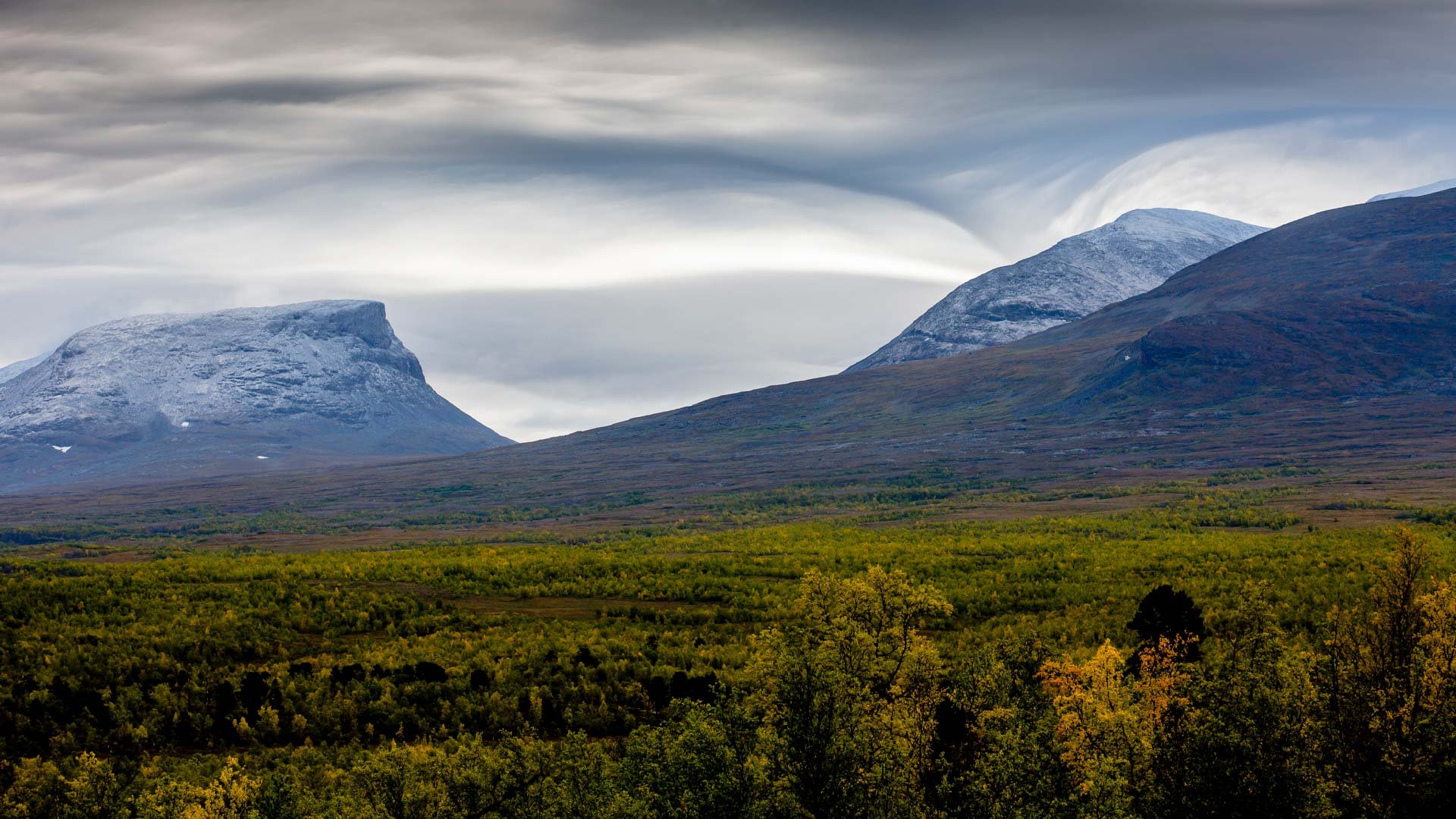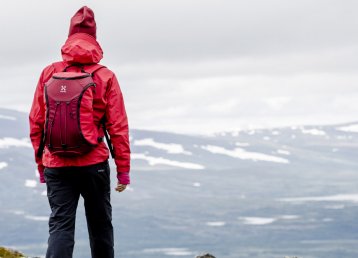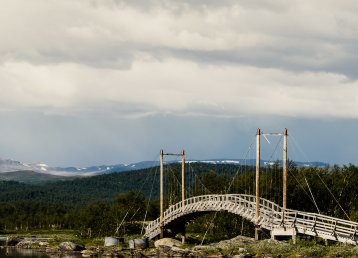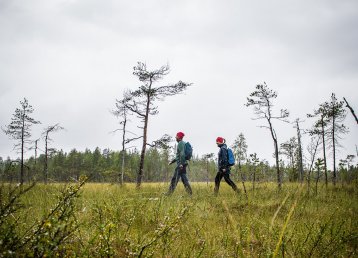We left a little too late from Björkliden on our hike to Låktatjåkko mountain station. Guidebooks and information usually say it is nine kilometres. But take it with a pinch of salt because it can be a few kilometres longer. At least, that is what it always feels like. As a hiker, you have known for a long time that instead of counting kilometres, you count hours. Nine kilometres equals about three hours hiking. It is a simple rule to stick to for mountain hikes: three kilometres takes about an hour. Similarly, 300 metres of altitude takes an hour to climb. This corresponds to a leisurely but steady hiking pace. In order to make it to our dinner reservation at Låkta, we had just over two hours to get there, so we had to hurry. As much as I prefer not being late for a nice dinner, I would rather not run to get there. But now we are here, with a chilled Chablis, fried Arctic char and a view worthy of a mountain hiker.
Eating well
We are going to hike in the Kiruna mountains for a week and – well, perhaps primarily – eat well. As soon as we enter the station at Låktatjåkko, bathed in the midnight light this fair-weather evening, leave our backpacks, sit down at the table and are served a glass of something, calm reigns supreme. Starter, main course and dessert follow before our hostess Ulrika tells us where to check-in and where we will be staying the night. She also informs us that the sauna is still hot and that we will be able to see the midnight sun from the top of Låkta this evening. We do as we are told. We finish eating, have a sauna, make ourselves at home and then go for a walk towards the summit at Låktatjåkko. The view is delightful in all its rocky desolation. The sun stays above the horizon. There is something special about this phenomenon of eternal summer light – that the sun stays above the horizon for two months in a row, and then it stays bright all day and night for yet another month. I can never really get enough of it.
In the morning, we have breakfast at the mountain station. We are in no real hurry since we have decided to stay here for two nights. Today we are taking a day hike over towards Kårsavagge. The hike, where if you were to continue, would take you to Abisko. We are going there eventually, but not today. Today we are just going on a nice day hike. This evening, slow-cooked elk awaits us for dinner at Låktatjåkko. I asked about this before we left. There will also be vendace roe on a classic Låkta waffle.
Also read
The gold of the Bothnian BayHiking at a wine-glass distance
Osvald Jonsson, who runs Fjällhästen in Ammarnäs, coined the term “Hiking at a wine-glass distance” when explaining what comfortable day hikes were all about. Ammarnäs is a perfect location for that kind of hike. You stay comfortably in the village and go out on various day trips. Always with your home base and the restaurants nearby. The good life tucked into a pair of hiking boots. There are many other places in the mountains for it too, of course: Saltoluokta, Vuoggatjålme, Årrenjarka, and others are ideal for that kind of comfortable stop. What you want is to find a place with at least some ‘loops’ or tours available. Walking the same stretch back and forth during a long weekend is not particularly exciting. But if you have some peaks and a couple of routes that loop around the landscape, you have some very nice days indeed ahead of you. We have chosen the Kiruna mountains: Abisko, Björkliden and Riksgränsen, because there are some really nice hikes here that are easily accessible, and at the same time, there is excellent cuisine available within ‘wine-glass distance’.
Views
In the afternoon, on the third day, we walk down from Låktatjåkko to spend a night in Björkliden. I have a burger and a Pils in the lobby bar. Sometimes that is all you need after a day of hiking. I may be wrong, but the salt on the chips feels almost like it is good for you after a day in the heat, clad in hiking boots. There is nothing glamorous about the burger, but the view of Čuonjávággi (“The Lapponian Gate”) from the lobby of Hotel Fjället is something extraordinary. It is iconic in every sense and almost impossible to stop looking at.
The next day we tackle the immediate area around Björkliden before a change of scene. We take a reconnaissance trip, from waterfall to waterfall. We go west, past the crater lake Kratersjön until we reach the Navvy Road, which we follow back to the hotel. But we do not stop there; we continue east for a kilometre and a half to Koppasjokken and some other nice waterfalls. Our packed lunch disappears as we are sat in the sunshine by the caves at Koppasjokk. I take the opportunity to climb down a few metres into the cave entrance, and the wind blowing from the underground is chilly indeed. When we feel ready, we walk down to the perhaps most famous waterfall in Björkliden, the Silver Fall, or Rákkasgorži in Sámi, down by the E10. There is also a wonderful beach with rounded pebbles. We deserve a quick dip, warmed by the sun as well as the view of Čuonjávággi.
Living in a dream
Niehku means dream in Northern Sámi, and for many who have visited Riksgränsen since the days of Olle Rimfors, a hotel such as Niehku Mountain Villa is a dream come true. As you take a seat in the restaurant and are presented with the starter of the evening: a lightly cured reindeer tongue with a sauce made from reindeer blood, followed by fried pork rind, you know this will be a great evening. A classic Niehku reindeer tartare with almond potato crisps is served, and it all starts to feel like a familiar dream. Niehku really is a crazy project. Two friends, Strumpan and Jossi, together with a couple of good financial backers, have built one of Sweden’s coolest designer hotels, basically as far north and as far away as you can get. The hotel has not just received good reviews in Sweden: in 2019, Niehku won the Prix Versailles for the best hotel interior in the world. Not quite what you were imagining when you were here climbing on the industrial ruin that runs straight through the hotel nowadays. This used to be a train depot where trains were repaired on their journey between the mine in Kiruna and the port in Narvik. One of the grease pits in those locomotive sheds has actually become another cool design effect: a wine cellar sunk into the restaurant’s glass floor.
Niehku Mountain Villa
The northern Sámi word for dream is niehku. And as a design hotel and a hideaway in an Arctic environment, Niehku Mountain Villa is a stunning place. From food to heli-ski, from interior design to a mountain vista, this is really a dream come true.
The beautiful stone valley
The hike at Riksgränsen is also a nice, easy one. A trip up to Lake Katterjaure followed by an easy ascent of the mountain Nordalsfjäll before you sneak back to the hotel via the route known to skiers as ‘the Big Beer Tour’, leading past the houses on the Norwegian side in Björnefjell. This is a nice, slightly more challenging day trip that offers many different types of nature and views.
Another hike not to miss is from Kärkevagge to Lake Trollsjön. In Sámi, the valley is called Geargevággi, which became Swedish Kärkevagge, and it translates to Stone Valley in English. As you hike up it, you understand why. The most beautiful formations in the valley are all the amazing stone pillars. At the end of the valley is Rissájávri, commonly referred to as Trollsjön: Troll Lake. This small lake boasts the clearest water in Sweden, with a visibility of more than 30 metres. When you jump in, it sometimes feels like it has the coldest water in Sweden, too. In any case: Kärkevagge is a wonderful hike for young and old, and the valley’s stone formations always catch the attention of hikers who want something to show on their Instagram feed. When the day comes to an end, you walk further down and dreamily return to comfort.
Also read
The secret stone valleyWild flavours
The last days of this gourmet hike are spent at Abisko Mountain Lodge. Once upon a time, Dick and Mina Johansson-Dahl built it to look after heli-skiers in winter and mountain climbers in summer. But their kitchen – Brasserie Fjällköket – became increasingly popular. Today, their business is also made up of northern-light tourists in winter and visitors who need wild wellness in summer. Those who like to eat well and feel good. This evening’s starter is cauliflower soup with cured reindeer topside, which tastes wonderful together with the Spanish cava I have as a pre-drink. There is a cod back fillet to come.
One of the advantages of this area, the Kiruna mountains, is that all the local produce provides those typical wild flavours from the Swedish mountain world. Still, there is also the free-range lamb from the Norwegian cultural landscape and all the fruits of the Atlantic. If you are sat in Riksgränsen, you can almost throw a stone down into the sea at Rombacksfjorden, or at least it is a nice hike or bike ride going there. Then there are just a few more kilometres to go to Abisko. It is a nice mix of typical northern flavours, and you will not escape the hand-picked cloudberries or the slow-cooked elk. They are a must, and they taste good. Perhaps especially so since you took the opportunity today to enjoy the most accessible mountain world in Sweden, again: the lift up to Aurora Sky Station, on the mountain Nuolja. Since you felt like it, there was, of course, time for coffee and cake there before you walked down to Fjällköket. To enjoy yet another pre-ordered dinner party at a wine-glass distance.




































